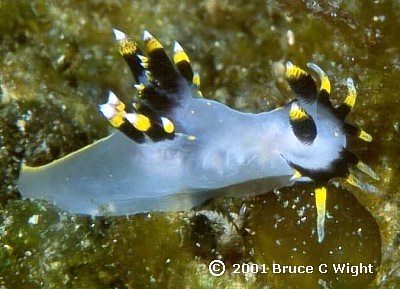
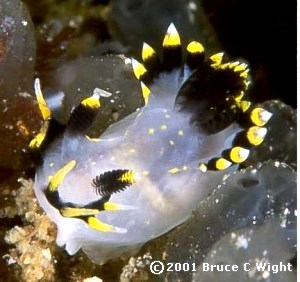
Polycera tricolor
Robilliard, 1971
Order: NUDIBRANCHIA
Suborder: DORIDINA
Superfamily: ANADORIDOIDEA
Family: Polyceridae
DISTRIBUTION
British Columbia, Canada to Baja California, Mexico
PHOTO
San Clemente Island, Southern Channel Islands, California. 80-120 feet. Photos: Bruce C. Wight
Translucent white with 5-10 frontal appendages and 4-6 extrabranchial appendages on each side. The frontal appendages have a black base, a yellow midregion and an opaque or translucent white upper third. The extrabranchial appendages have a black basal half, then an yellow band and an opaque white tip. The rhinophores are similarly coloured. There is a yellow band down the dorsal midline from the gills to the posterior tip of the foot, and in some animals the foot can have a yellow border. It grows to about 20mm in length.
Reference:
• Robilliard, G.A. (1971) A new species of Polycera (Opisthobranch: Mollusca) from the northeastern Pacific, with notes on other species. Syesis 4: 235-243.
Rudman, W.B., 2001 (June 1) Polycera tricolor Robilliard, 1971. [In] Sea Slug Forum. Australian Museum, Sydney. Available from http://www.seaslugforum.net/find/polytric
Related messages
Polycera tricolor with amphipod from British Columbia
November 24, 2008
From: Marli Wakeing
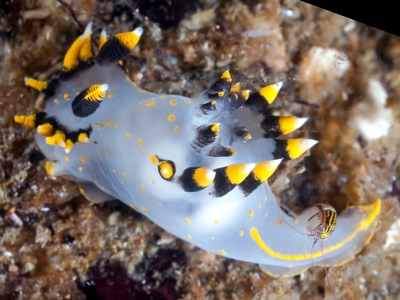
Hi Bill,
This Polycera tricolor has a striking looking amphipod on its back. The colouration can't be a coincidence, it is so well matched. Is this association known? If so, what is the amphipod, and is it a parasite, or simply hitchhiking?
Locality: Barkley Sound, 9 feet, British Columbia, Canada, 18 May 2008, Rock reef. Length: 20 mm. Photographer: Marli Wakeling.
Cheers,
Marli
scubamarli@gmail.com
Wakeling, M., 2008 (Nov 24) Polycera tricolor with amphipod from British Columbia. [Message in] Sea Slug Forum. Australian Museum, Sydney. Available from http://www.seaslugforum.net/find/21972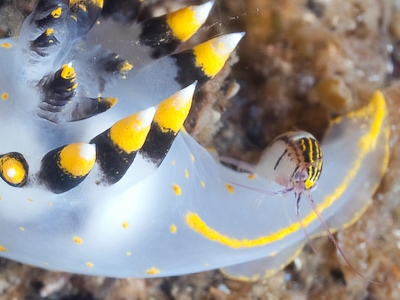
Hi Marli,
According to Lamb and Hanby, the amphipod is Chromopleustes oculatus. There is likely no association here as this pretty species of amphipod has its own chemical defence to repel predators. It was just likely taking a stroll in the park.
Thanks for sharing this,
Dave Behrens
Polycera tricolor feeding - British Columbia
October 16, 2008
From: Marli Wakeling
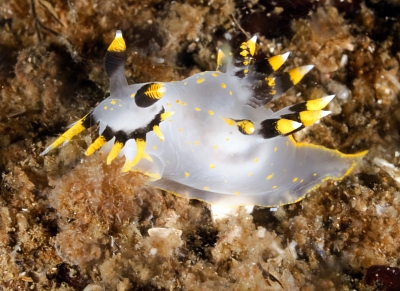
Concerning message #8190:
Hi Bill,
In going through some images from last spring, I found some of Polycera tricolor apparently feeding on the lophophores of some bryozoan that is pretty much buried in deritus. There were a number of them directly under the dock in less than 3 metres. The caprellid shrimp you can see sitting on the bryozoan did survive, by the way.
Locality: Barkley Sound, 9 feet, British Columbia, Canada, Pacific, 18 May 2008, Rock reef. Length: 20 mm. Photographer: Marli Wakeling.
Cheers,
Marli
scubamarli@gmail.com
Wakeling, M., 2008 (Oct 16) Polycera tricolor feeding - British Columbia. [Message in] Sea Slug Forum. Australian Museum, Sydney. Available from http://www.seaslugforum.net/find/21971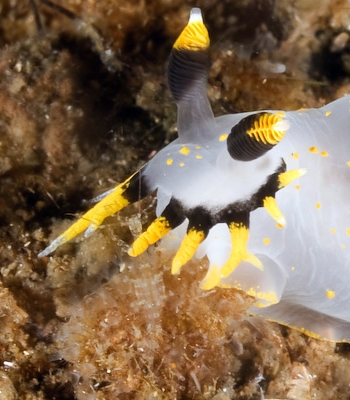
Thanks Marli,
Best wishes,
Bill Rudman
Polycera tricolor from California
October 18, 2002
From: Bruce Wight
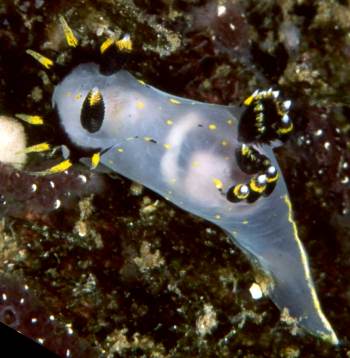
Hi Bill,
Here is a photo of Polycera tricolor I took on a three day trip out to Anacapa and Santa Barbara Islands, California [Septemver 2002]. Dive conditions were pretty bad with heavy surge and current in most of the areas we dove. There were a great many Tritonia festiva out on the South end of Anacapa in about 40-50 feet depth.
Bruce Wight
bwproductions@earthlink.net
Wight, B., 2002 (Oct 18) Polycera tricolor from California. [Message in] Sea Slug Forum. Australian Museum, Sydney. Available from http://www.seaslugforum.net/find/8190Thanks Bruce,
Bill Rudman
Polycera tricolor from California
June 3, 2001
From: Bruce Wight

Hi Doc,
Just got back [May 2001] from San Clemente Island which is one of our Southern Channel Islands off California. Lots of Polycera tricolor nudibranchs. Most were found between 80 and 120 feet. Water temp was 60 degrees F. As you can tell by the photos it was pretty surgy. The body is almost translucent on the image of the one laying eggs.
Take care,
Bruce Wight
bwproductions@earthlink.net

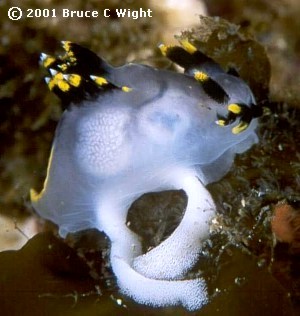
Thanks Bruce,
It's interesting how many species of Polycera are white with yellow, and sometimes black markings [P. atra, P. capensis, P. faeroensis, and P. quadrilineata].
Best wishes,
Bill Rudman
